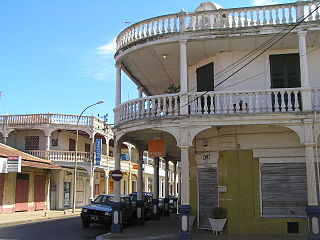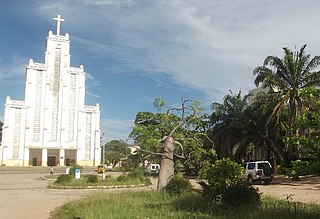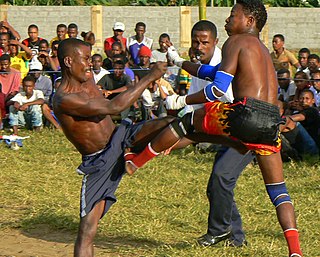| Total population | |
|---|---|
| 25,000 [1] | |
| Regions with significant populations | |
| Antananarivo | |
| Languages | |
| Gujarati, English, Telugu, Tamil, French, Malagasy, Hindi, Languages of India | |
| Religion | |
| Hinduism; Islam, including Sunnism, Shi'ism, Isma'ilism, and Bohra | |
| Related ethnic groups | |
| Overseas Indians |
The so-called 'Karana' are a racial group in Madagascar with a long history on the island. The Malagasy term refers to Khoja and Indian families on the island who are generally perceived to control the economic affairs of the country due to their good business acumen. Though they have contributed greatly to the nation's development, unlike their counterparts in Oman they do not enjoy the same level of acceptance and freedom with kidnappings rife and a lack of acceptance into the institution both politically and otherwise. [2]
Estimates of their population range from 15,000 to 30,000. The group migrated from the Indian subcontinent somewhere between five and fifteen generations ago, spearheaded by the Khoja tribe with many Indians joining alongside.
Among those that are commonly referred to as 'Indians in Madagascar' today, are 867 non-resident Indians, with the rest being locally born descendants of early immigrants Khojas or Indians. [1] [3] They form a minority ethnic group in Madagascar.
By the 1780s, a community of roughly 200 Indian traders had formed at Mahajanga, a port on the north-west coast of Madagascar, near Bombetoka Bay at the mouth of the Betsiboka River. Confusion arose over their legal status; they often declared themselves to be Malagasy subjects in order to evade the laws against slave-holding or the building of stone houses, both forbidden to British subjects, while their dhows , which they used to transport goods to and from the African mainland, flew French flags. [4] French Khoja families today come from once Madagascar-based communities when the nation was part of the French Empire and those under it French citizens.
In fact, even those families still based in Madagascar today are almost all French with links between the two still intact and regular travel between the French republic and the Great Red Island occurring due to business interests and education amongst other factors. It is not uncommon for a Frenchman of Khoja ethnicity to view Madagascar as the 'land of his ancestors'.
Initial arrivals to the island were mainly Muslim Twelver Khojas, Ismailis and Daoudi Bohras, with some Hindus settling later. [5] The 1911 census found 4,480 Indians in the country, making them 21% of the total foreign population and the second-largest foreign population after the French. [6] Following the nationalisation of private businesses in the 1970s, many were compelled to leave; those who remained were largely uneducated, but stayed on and gradually built their businesses. By 2000, they were generally believed to control 50-60% of the country's economy, making them the target of demonstrators during periods of unrest. [7]

Madagascar, officially the Republic of Madagascar, is an island country comprising the island of Madagascar and numerous smaller peripheral islands. Lying off the southeastern coast of Africa, it is the world's fourth largest island, the second-largest island country and the 46th largest country in the world. Its capital and largest city is Antananarivo.

The history of Madagascar is distinguished clearly by the early isolation of the landmass from the ancient supercontinent of Pangaea, containing amongst others the African continent and the Indian subcontinent, and by the island's late colonization by human settlers from the Sunda islands and from East Africa. These two factors facilitated the evolution and survival of thousands of endemic plant and animal species, some of which have gone extinct or are currently threatened with extinction. Trade in the Indian Ocean at the time of first colonization of Madagascar was dominated by Indonesian ships, probably of Borobudur ship and K'un-lun po types.

Demographic features of the population of Madagascar include population density, ethnicity, education level, health of the populace, economic status, religious affiliations and other aspects of the population.

Antananarivo, also known by its colonial shorthand form Tana, is the capital and largest city of Madagascar. The administrative area of the city, known as Antananarivo-Renivohitra, is the capital of Analamanga region. The city sits at 1,280 m (4,199 ft) above sea level in the center of the island, the highest national capital by elevation among the island countries. It has been the country's largest population center since at least the 18th century. The presidency, National Assembly, Senate, and Supreme Court are located there, as are 21 diplomatic missions and the headquarters of many national and international businesses and NGOs. It has more universities, nightclubs, art venues, and medical services than any city on the island. Several national and local sports teams, including the championship-winning national rugby team, the Makis, are based here.
The terms multiracial people or mixed-race people refer to people who are of more than one race, and the terms multi-ethnic people or ethnically mixed people refer to people who are of more than one ethnicity. A variety of terms have been used both historically and presently for mixed-race people in a variety of contexts, including multiethnic, polyethnic, occasionally bi-ethnic, Métis, Muwallad, Melezi, Coloured, Dougla, half-caste, ʻafakasi, mestizo, mutt, Melungeon, quadroon, octoroon, sambo/zambo, Eurasian, hapa, hāfu, Garifuna, pardo, and Gurans. A number of these once-acceptable terms are now considered offensive, in addition to those that were initially coined for pejorative use.

Antsiranana, named Diego-Suarez prior to 1975, is a city in the far north of Madagascar. Antsiranana is the capital of Diana Region. It had an estimated population of 115,015 in 2013.

Mahajanga is a city and an administrative district on the northwest coast of Madagascar. The city of Mahajanga is the capital of the Boeny Region. The district had a population of 258,068 in 2020.

The Merina people are the largest ethnic group in Madagascar. They are the "highlander" Malagasy ethnic group of the African island and one of the country's eighteen official ethnic groups. Their origins are mixed, predominantly with Austronesians arriving before the 5th century AD, then many centuries later with mostly Bantu Africans, but also some other ethnic groups. They speak the Merina dialect of the official Malagasy language of Madagascar.

The Malagasy are a group of Austronesian-speaking ethnic groups indigenous to the island country of Madagascar. Traditionally, the population have been divided into ethnic groups. Examples include "Highlander" groups such as the Merina and Betsileo of the central highlands around Antananarivo, Alaotra (Ambatondrazaka) and Fianarantsoa, and the "coastal dwellers" such as the Sakalava, Bara, Vezo, Betsimisaraka, Mahafaly, etc.

Islam in Madagascar is a minority religion, with most Malagasy adhering to Christianity. Due to secular nature of the Madagascar's constitution, Muslims are free to proselytize and build places of worship in the country.

The history of Hinduism in Madagascar began with the arrival of primarily Gujarati from the Saurashtra region of India as far back as 1870. These were predominantly Muslim, but a small number were Hindus.

Malagasy cuisine encompasses the many diverse culinary traditions of the Indian Ocean island of Madagascar. Foods eaten in Madagascar reflect the influence of Southeast Asian, African, Oceanian, Indian, Chinese and European migrants that have settled on the island since it was first populated by seafarers from Borneo between 100 CE and 500 CE. Rice, the cornerstone of the Malagasy diet, was cultivated alongside tubers and other Southeast Asian and Oceanian staples by these earliest settlers. Their diet was supplemented by foraging and hunting wild game, which contributed to the extinction of the island's bird and mammal megafauna. These food sources were later complemented by beef in the form of zebu introduced into Madagascar by East African migrants arriving around 1,000 CE.

The culture of Madagascar reflects the origins of the Malagasy people in Southeast Asia, East Africa and Oceania. The influence of Arabs, Indians, British, French and Chinese settlers is also evident.

Andriana was both the noble class and a title of nobility in Madagascar. Historically, many Malagasy ethnic groups lived in highly stratified caste-based social orders in which the Andriana were the highest strata. They were above the Hova and Andevo (slaves). The Andriana and the Hova were a part of Fotsy, while the Andevo were Mainty in local terminology.
Chinese people in Madagascar are a minority ethnic group of Madagascar and form Africa's third largest overseas Chinese population with a population estimated at between 70,000 and 100,000 in 2011.

Moraingy is an unarmed, bare-fisted striking style of traditional martial art from Madagascar.

Indonesia–Madagascar relations spans for over a millennium, since the ancestors of the people of Madagascar sailed across the Indian Ocean from the Nusantara Archipelago back in 8th or 9th century AD. Indonesia has an embassy in Antananarivo, while Madagascar does not have an accreditation to Indonesia. It was announced in December 2017 that Madagascar would be opening an embassy in Jakarta in 2018, however, the embassy was never opened.

Christianity in Madagascar is practiced by 85.3% of Madagascar's population according to the Pew Research Center in 2020. However, other surveys put the figure at 58%. Malagasy Christianity is generally practised in syncretic form with traditional religious practices.
Vy Vato Sakelika was a nationalist secret society formed in Madagascar in 1913 by HovaMerina elites to inspire rebellion against French colonial rule on the island.

Malagasy nationality law is regulated by the Constitution of Madagascar, as amended; the Malagasy Nationality Code, and its revisions; and various international agreements to which the country is a signatory. These laws determine who is, or is eligible to be, a national of Madagascar. The legal means to acquire nationality, formal legal membership in a nation, differ from the domestic relationship of rights and obligations between a national and the nation, known as citizenship. Nationality describes the relationship of an individual to the state under international law, whereas citizenship is the domestic relationship of an individual and the nation. Malagasy nationality is typically obtained under the principle of jus soli, i.e. by birth in Madagascar, or jus sanguinis, born to parents with Malagasy nationality. It can be granted to persons with an affiliation to the country, or to a permanent resident who has lived in the country for a given period of time through naturalization.